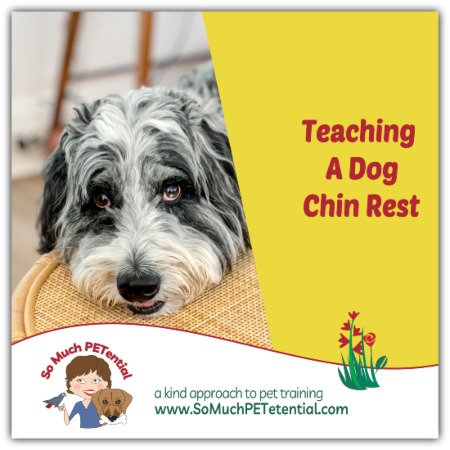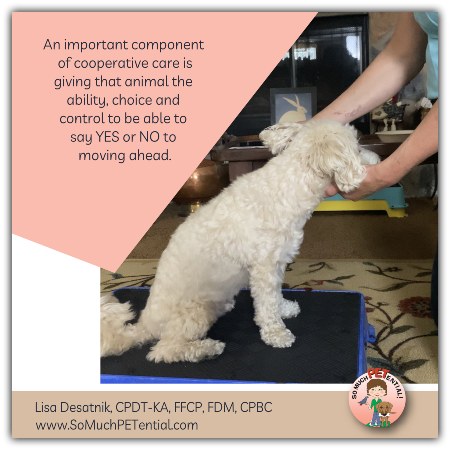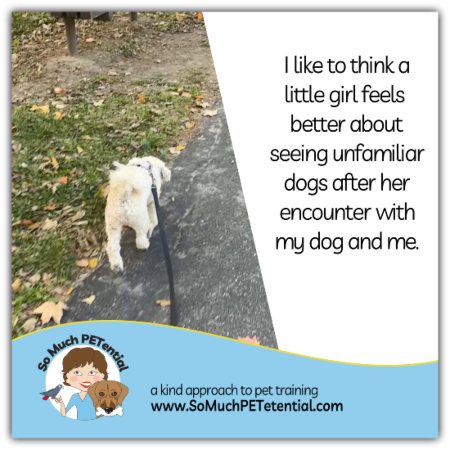There are so many benefits to teaching your dog chin rest…Fear Free cooperative care handling is among them. (Please continue reading to learn more.) However, if you have already trained your dog to do a strong hand touch or nose targeting behavior, it can complicate this dog training lesson. No worries! It just means thinking creatively to problem solve.

What is a dog chin rest?
Simply put, a dog chin rest is the behavior of your dog laying his chin on a surface such as your palm, your lap, a bench, or another type of prop.
What are the benefits of training this dog behavior?
Firstly, it can be useful and/or part of training dog trick behaviors. Let’s say you would like your dog to learn how to lay ‘splat’. As an example, you can teach your dog to lay down, then incorporate the chin rest on the floor, and then name the end ‘chained’ behavior as ‘splat’.
Chin rest can be used in playing mental games. You could send your dog to chin rest on something, then send your dog to get a reinforcer. You can ask your dog to chin rest different objects.
You can use this behavior to lower arousal and teach calmer state of mind. When your dog is resting his chin on a surface, his mouth is closed. You can incorporate this with deep breathing exercises.
A very important use of chin rest is as part of Fear free cooperative care, which refers to your dog opting in or giving consent to handling. This involves teaching your dog that laying his chin on something is his GREEN LIGHT for indicating he is opting in or consenting to what you are needing to do, whether that be checking his ears, giving eye drops or a shot, or something else. If your dog raises his head, that indicates RED LIGHT to stop what you are doing.
Allowing your dog to make that choice can go a long way to reducing stress with handling. I have videos in this blog post about Fear Free cooperative care.
Teaching Your Dog Chin Rest
Often, but not always, dog parents have already taught strong hand targeting (your dog touching his nose to your palm) or other conflicting behaviors that can potentially make it confusing for your dog to learn – and you to teach.
My dog is a great example. Dawson knows nose targeting very fluidly. He also has a very strong paw targeting behavior. Anytime I put something on the ground, his first instinct is, “Oh, I need to put one or two paws on it.”
With him, this is how I worked around this challenge.
First, while Dawson was sitting (he could stand also), I simple fed him one treat at a time, five times.
Then, I held the palm of my other hand under his chin (I began with that palm about four inches below his chin) while I fed him the treats.
Then I moved that palm higher. Then moved it higher.
I did this until my palm was just under his chin. At this point, when I fed him the treats, I fed the treats from a slightly lower position than the palm so that he pushed his chin into that palm to get the treat.
I repeated this.
(Total time for this lesson was no more than two minutes before I stopped and came back to it later.)
The more we practiced, the more fluid it became until I would show him my palm and he knew to place his chin on it.
At this point, I inserted a verbal cue, CHIN, just before he put his chin on my palm. The reason I used a verbal cue is so that he understands what he should do (nose touch vs chin). We also practice this skill with different props.
This dog, Disco, also already has been taught a very strong nose to hand target and it is a behavior that is very energetic for him – which is NOT what we want when teaching chin rest to palm or another prop. I first tried the two methods I used with my own dog. Disco still struggled and he is a very smart, eager-to-learn student.
For Disco, what helped him was teaching the behavior with a table top that is a perfect height for him to easily lay his chin on it.
With this training set up change, he began learning fast. Not captured in the video, once he learned the presence of the table meant ‘put my chin on it’, then I added a verbal cue. Then, I began teaching him to generalize that behavior with different objects until finally, I could present my palm – even from a distance – and tell him ‘CHIN’ and he would move quickly into position.





